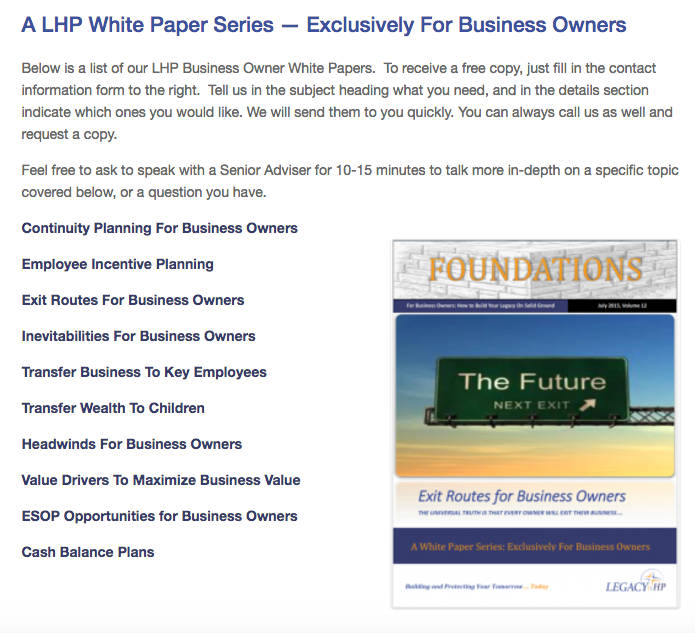Experts and laymen agree that one constant of successful companies is a stable, motivated management team. This quality not only contributes to corporate success, it is also key to the business owner’s successful business exit.
Should you decide to sell your business to a third party, you’ll discover that potential buyers place significant value on the strength of your management team—if that management team can be expected to remain after you have left the business. Similarly, if you contemplate selling the business to family (or to employees), the likelihood of being paid for the business after you’ve left can be entirely dependent on the strength of your remaining management team.
In short, capable management remaining with the company can be the key to getting top dollar for your business. Without such management your exit may be more difficult.
One of the many factors involved in creating, motivating and keeping good management is the creation of a properly designed incentive plan for key employees. To be successful, an incentive plan must motivate the management team to increase the value of the company in a measurable way. Only by increasing company value do employees receive the incentive (ownership or cash).
Successful plans share four basic elements:
First, the plan is specific. Employees know, in advance and in writing, what standards need to be met to receive the incentive.
Second, the incentive is substantial. For many years, a bonus of at least 10 percent of annual compensation, (again in stock or cash) was the minimum necessary to motivate a key employee. But today, the minimum potential incentive has risen to 25 percent of annual compensation, and sometimes more. This substantial amount is only earned and paid upon the attainment of a performance standard that you set.
Third, the plan handcuffs management to the business. Employees are motivated to stay with the company in the short term as well as (and more importantly) after you’ve left it.
Fourth, the key employee earns the incentive bonus based on a performance standard, that, when attained,increases the value of your business.
This fourth element is critical to a properly designed incentive plan.
Management incentive plans are based upon the assumption that the plan provides incentive. What is often less clear is exactly what the incentive motivates the employee to do. Effective incentive plans motivate employees to act in ways that increase business value. Remember, your ultimate goal is to build enterprise value that you will someday convert to cash.
Pay careful attention to the design—and consequences—of the performance standard. Consider the following:
- A performance criterion can be any standard that you dream up because incentive plans are "nonqualified," (they carry no special benefits under the U.S. Tax Code) and therefore can be restricted to management.
- The performance standard, when met, must measurably increase business value. Because the goal is to provide more cash to you when you leave via the conversion of that increased value to cash, many owners decide to measure value in terms of increasing cash flow. In addition, buyers (especially those of service companies) typically use valuation formulas based upon a multiple of cash flow. Performance standards based on increasing cash flow are attractive to both key employees and owners.
- When you determine how best to measure cash flow for purposes of an incentive plan, start with the amount of cash the company generates and pays to you in the form of salary, bonus, distributions, and excess rent. Add to that the cash flow amount retained in the company that could be distributed to you, but that you elect to keep in the company for growth and capitalization. More or less, that sum is the available cash flow stream that should increase as the efforts of your management increase business value. This formula can put more money in your pocket today and on the day you sell.
Here are a few examples of formulas that work equally well for stock (equity) or cash-based plans.
- Key Employees earn a percentage above a base cash flow amount (perhaps 30 percent of cash flow over $100,000). If cash flow falls below the base of $100,000, bonuses are not earned. The base amount can reflect last year’s cash flow or the amount retained in business for capitalization purposes or a reasonable return on the assets of the company (cash flow the management team did nothing to create). Incentives can be paid in stock or cash and deferred until a specific date.
- The incentive amount can be a percentage above a base amount (as in the example above), except that it is a percentage of cash flow that adjusts as cash flow increases or decreases.
- The incentive can be a percentage of growth in adjusted revenues of the company, or perhaps of adjusted revenues above a certain base level. For example, gross revenue less the Cost Of Goods Sold (COGS) is the "top-line" reduced by a base amount, with Key Employees receiving a percentage of the amount above that base level.
- Some incentive formulas reflect the desired financial/cash flow condition of the company. If the goal is attained in a specific year, the Key Employees are allowed to buy a portion of the company—usually paid for with the future cash flows from the stock just purchased. For example, if revenues, (or revenues adjusted for COGS), or cash flow reach a base level of $X (described in the incentive agreement), eligible Key Employees are entitled to purchase a predetermined percent of the outstanding stock of the company.
These are just a few of the many formulas you can use to effectively motivate your key employees to increase the cash flow, the financial strength, and ultimately the value of your business. The professional who sent you this newsletter should be able to help you design a formula that works best for you, your employees and your company.
Take care and have a good day,
Michael
ABOUT LEGACYHP: Our passion is our mission -- To position our clients into a positive, energized, posture -- within your businesses and within your lives -- So that you manage change confidently, take decisive action, and enjoy life's journey Today... while you enjoy building your Legacy for Tomorrow.
Notice: The information contained in this article is general in nature and is not legal, tax or financial advice. For information regarding your particular situation, contact an attorney or a tax or financial advisor. The information in this newsletter is provided with the understanding that it does not render legal, accounting, tax or financial advice. In specific cases, clients should consult their legal, accounting, tax or financial advisor. This article is not intended to give advice or to represent our firm as being qualified to give advice in all areas of professional services. Exit Planning is a discipline that typically requires the collaboration of multiple professional advisors. To the extent that our firm does not have the expertise required on a particular matter, we will always work closely with you to help you gain access to the resources and professional advice that you need.



